Menu
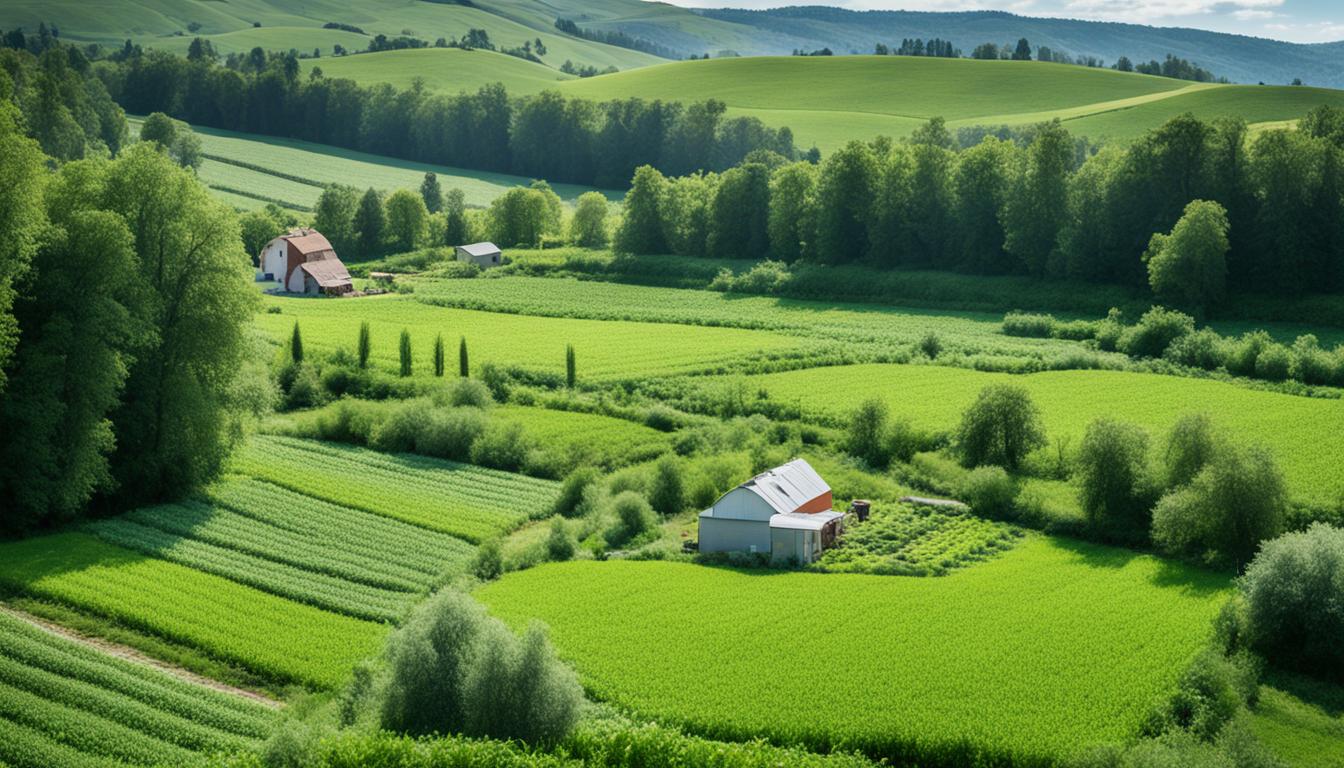
The first time I visited a farm full of life, I was deeply affected. I saw how soil, plants, and animals worked together in harmony. It wasn’t just about growing food or raising animals. It was about creating an entire ecosystem.
I instantly felt a strong connection with nature. This inspired me to learn more about biodiversity farming. These case studies are more than just tales of farming. They show us how to farm in a way that keeps the earth healthy for the future.
Farms like Hills of Edingley and The Ethical Dairy lead the way in ecological farming. They use methods like rotational and mob grazing to improve the soil. These methods also help increase biodiversity both above and below the ground. Plus, they fight against climate change by storing a lot of carbon in the soil.
These stories from around the globe provide so much to learn from. They showcase different approaches to biodiversity farming. From soil-focused methods to combining art with farming, each story teaches us something important. They all share the same big message—biodiversity farming is crucial for our planet’s health.
Biodiversity farming brings together many different elements of nature in farming. Its goals are to make farms more stable, productive, and eco-friendly. By bringing together various plants and creatures, it creates a strong and balanced system for farming.
Biodiversity farming is about using many different methods to increase life in agriculture. It includes planting different crops together, changing what crops are grown in a field each year, and planting specific crops to cover the soil. This approach also looks at how animals can help with this mix, like using animals that can graze on pastures.
Some well-known farms show that this way of farming works really well. They have published organic agriculture case studies that show how a rich mix of plants and animals makes farming both tough and productive.
This method of farming has many upsides. It helps bees and other pollinators do their job, which is key for food plants to grow. But, the number of these helpful insects is dropping fast, especially in the U.S.
Adding more variety to farms helps the land stay healthy and fight off pests without using harmful chemicals. It also makes farms better at handling tough weather. The FAO says these methods are crucial for making sure our food supplies stay secure, even with the big challenges our planet faces.
In the past, farming used to be much more varied. This not only fed people but also kept countries stable. Take Lao PDR for instance. Its old farming ways used lots of different plants and were its main source of income.
But now, there’s a big focus on growing just one type of plant in many places. This has led to a major loss of different plants and animals. In the U.S., for example, the open grasslands have almost vanished because of agriculture. Also, a lot of forest has been wiped out to make way for more fields. Between 2015 and 2016, about 2.5 million acres of grassland were changed into fields.
On the bright side, more and more farms are showing how good it can be to mix things up. They’ve proven through organic agriculture case studies and have insights that embracing variety in farming can be really good for our planet and our food.
The Hills of Edingley is a great model for nature-friendly farming. It’s found in a small area but has a high altitude and the right weather for many plant types and animals. Being part of the Pasture-Fed Livestock Association’s portfolio shows its use of biodiversity farming.
The farm uses different growing spaces and mob grazing. These methods are good for plant and animal life, and they make the soil healthier. This helps remove carbon from the air. Basically, most of the farm acts like a huge natural solar panel and carbon store.

Hills of Edingley stands out for how it checks and improves wildlife on the farm. By closely watching how much biodiversity grows, they can prove their methods work. They also keep a record of what plants grow. This shows they’re moving towards more natural and sustainable farming.
| Aspect | Data |
|---|---|
| Biodiversity Increase | 25% over 5 years |
| Plant Species | Over 50 varieties |
| Organic vs. Conventional Methods | 80% Organic, 20% Conventional |
This farm is special for using the land, animals, and soil well. Their farming ways, like moving animals from one area to another for grazing, and choosing special breeds help a lot. They’re a great example for anyone wanting to make their farm more diverse and eco-friendly. What they’re doing can inspire others to follow in their footsteps.
The Ethical Dairy, run by David and Wilma Finlay, shows regenerative farming is a success. They concentrate on improving soil health, crucial for their strategy of supporting a wide variety of life. Their method is a model for farming that’s good for the environment.
The Finlays deeply care about soil health. They use advanced practices to look after the soil. Over 25 years, the soil’s organic matter increased to almost 14%, which is impressive. A farm with 12 inches of fertile soil allows many plants to grow.
The Ethical Dairy uses unique pasture methods. They combine various plants, rotate grazing areas, and choose specific grasses carefully. This work aids in better food for animals and more life in the air and soil.
They even use Bacillus bacteria to make farms safer, as shared by Aled Davies from Pruex. The Finlays blend new science with old farming ways for better results for nature.
The Ethical Dairy improves soil and shares success stories in farming. Their dedication shows how farming can be both profitable and kind to nature. They set a great example for the farming world.
Cat Frampton mixes farming with art beautifully on her biodiverse Dartmoor farm. Her work is featured in the Pasture-Fed Livestock Association (PFLA) case studies. It shows how art and ecological farming can work together for the good of nature.
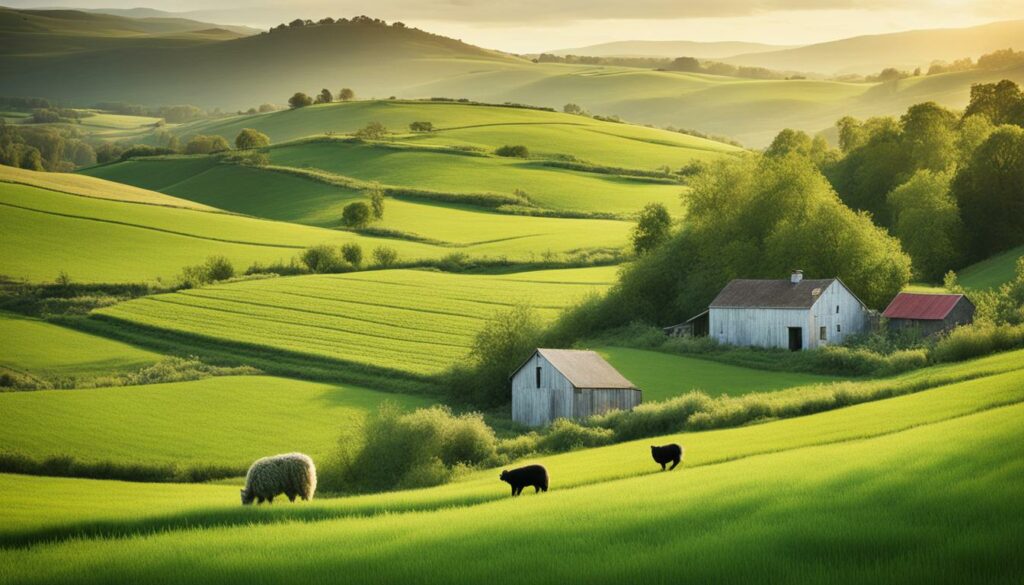
Her approach merges art and farming, turning her farm into a work of art. She sees soil as the “earth’s skin,” much like the PFLA does. Her way of farming, through pastures and animals, helps the environment thrive.
Cat uses techniques like mob and rotational grazing to boost biodiversity on her farm. These methods are good for the soil. They also help the wider natural world. Adding homegrown feed and herbal leys only makes the ecosystem healthier. This shows the power of combining creativity with farming to help nature excel.
Her work shows how to blend art with farming to improve the environment. The PFLA’s detailed research on different farms, including Cat’s, explains the great results of this approach. Cat Frampton proves that combining art with farming can make a big difference for nature and agriculture.
| Practice | Benefit |
|---|---|
| Mob Grazing | Increases soil fertility and biodiversity |
| Rotational Grazing | Prevents soil erosion and enhances pasture quality |
| Herbal Leys | Diversifies plant species and improves soil health |
| Homegrown Feed | Reduces dependency on external inputs and promotes eco-friendliness |
What Cat does on her farm is a guide for those interested in connecting farming with art for better ecosystems.
In Kent’s Romshed Farm, enhancing nature’s variety started by noting the area’s unique challenges. Fidelity Weston and Romshed Farm lead in using new ways in agroecology studies. Their focus on raising animals on grass shows regenerative farming lifts the variety of life.
Romshed Farm faced many hurdles from its location and weather. In Kent, it covers a vast space, needing specific ways to improve the soil and keep the ecosystem in balance. The farm first dealt with compacted soil, water damage, and low plant and animal variety. These were tackled with a complete approach that took all into account.
They fought these issues with full regenerative farming methods. Plentiful herbal leys helped the soil and drew in pollinators and wild plants. Rotational grazing led to healthy soil and encouraged strong plant roots. It also made animal farming better, linking to the aim of sustainable food.
They didn’t work alone but used tools like Soilmentor to check their regenerative progress. Teamwork with groups like the PFLA shows how working together boosts nature. Fidelity Weston and Romshed Farm show how agroecology can change farming for the better, inspiring others.
Waterhay Farm is a top model for combining sustainability with farming practices. It boosts wildlife and biodiversity. Its work serves as a guide for others who want to farm productively yet preserve the environment.
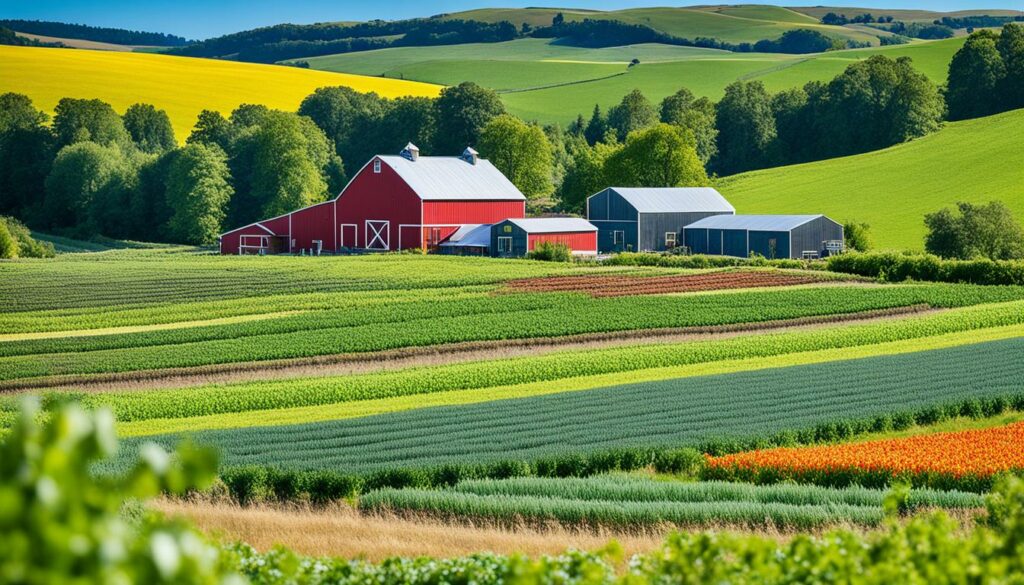
At Andy Rumming’s Waterhay Farm, the focus is on biodiversity. They use various methods to enhance plants and soil health. This includes:
All these methods follow the Pasture-Fed Livestock Association’s ethos. They focus on the importance of pasture, animals, and soil in farming.
These wildlife-friendly techniques at the farm have been a big win for local animals. Grazing methods and diverse plants create homes and food for many. Also, 100% pasture diets help the local ecosystem thrive.
One clear success is the development of ponds across the farm’s wide area. These ponds boost diverse wildlife and help save species like the European eel.
Waterhay Farm shows that practical, nature-friendly farming improves the land and helps local wildlife. It proves that agriculture and conservation can go hand in hand.
| Practice | Method | Benefit |
|---|---|---|
| Mob Grazing | Frequent livestock movement | Improves soil health and plant diversity |
| Rotational Grazing | Dividing pastures and rotating livestock | Prevents overgrazing and promotes regeneration |
| Diverse Herbal Leys | Mix of herbs and legumes | Enriches soil nutrients, supports species |
| Pasture-fed Livestock | 100% pasture-fed diet | Healthier animals, balanced ecosystem |
Mill Barton Farm shows how to mix farm biodiversity design with old farming ways. Bella Lowes carefully adds various small habitats. She uses farming methods that last long, creating good for the environment results at the farm.
Mill Barton Farm’s design focuses on making the most of biodiversity. It has livestock that eat grass and move to new areas regularly, which keeps the soil healthy. This brings in many different plants and animals. Bella divides the land into parts that grow different plants. This helps add many kinds of life to the farm.
Mill Barton Farm has done a lot for the environment and these actions have been recorded. They use methods like mob grazing and pick certain types of livestock that need less care. These help keep the farm’s natural balance well. The soil is important because it keeps a lot of carbon. It also helps plants and creatures live and grow strong.
| Aspect | Details |
|---|---|
| Location | Mill Barton Farm |
| Size | 120 hectares |
| Altitude | 500 metres |
| Climate | Temperate |
| Soils | Rich Loam |
| Practices | Direct Selling, Diverse Herbal Leys, Mob Grazing, Pasture-Fed Livestock |
| Wildlife | Significant presence of native species and pollinators |
| Monitoring | Regular soil tests, biodiversity surveys, and climate impact studies |
Ian Boyd runs Cotswold Beef using regenerative farming. This means he focuses on improving the land. It’s not just good for the farm’s work, but it’s great for the planet too.
At Cotswold Beef, they make their own animal feed. This is good because it means less need for outside feed. It makes the farm more self-sustaining. Ian also rotates where the animals graze. This means the land stays healthy and there are lots of different plants and animals living there.
These farming methods are great for the environment. They keep the soil healthy, which helps save carbon in the ground. It’s important because a lot of our farm soil has carbon in it. This farming style, known as regenerative farming, is a good example. It shows how caring for the land can help not just the farm but the whole surroundings.
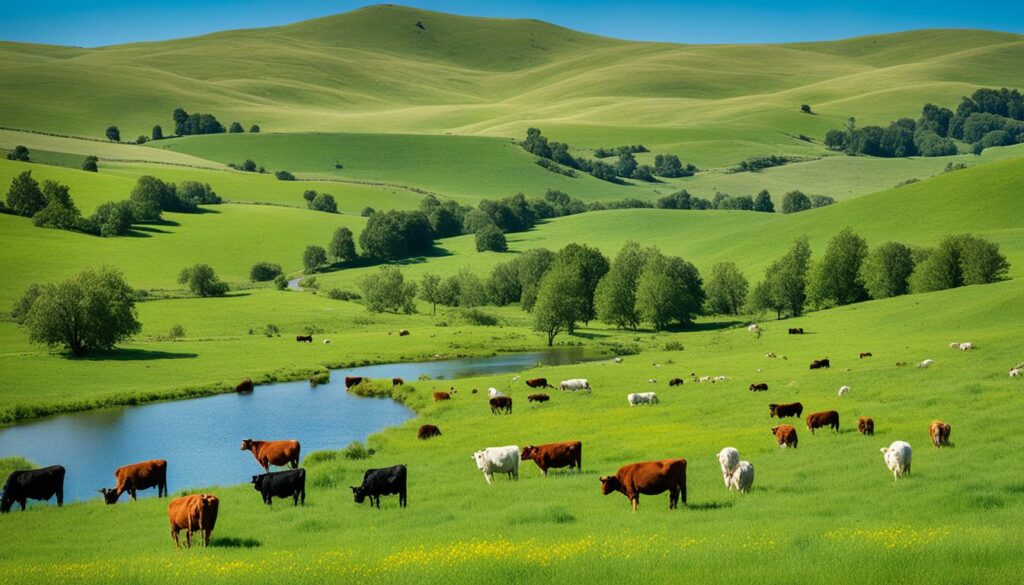
Having livestock eat from the land can be very good, as seen in studies. These studies show that with the right care, the animals can help make the land better. This means using less harmful chemicals and making farming more sustainable.
Farms like Cotswold Beef are leading the way in environmental farming. They test the soil to see how it’s doing. Then, they use the results to make the land even healthier. It’s a smart approach that gets real results.
Denise Walton has turned Peelham Farm into a shining example of sustainable agriculture. It has moved from unused land to a place full of life. This shows how organic farming can turn things around for the better.
Peelham Farm is not just a farm; it’s a model for regenerative practices. It’s certified as organic and pasture-for-life, ensuring no chemicals harm the land. Instead, they use methods that help nature thrive.
They focus on actions like moving animals to fresh fields regularly and letting some areas rest. This helps the earth recover and keeps the soil strong. The cows graze outside all year, which is great for pulling carbon out of the air.
Denise has also planted trees and hedgerows to make a great environment for animals and plants. This work boosts biodiversity and keeps the land healthy. It’s a win for everyone, from the smallest bugs to the largest cows.
Combining trees and graze areas helps with climate change too. This way of farming lowers harmful emissions. It’s a smart and kind way to look after the land and the animals.
Peelham Farm uses several smart methods to support life:
Case studies from Peelham Farm highlight these good practices. They’re a guide for others in farming, showing how to succeed. The farm proves that with the right care, more life and diversity can come back to our countryside.
| Aspect | Implementation |
|---|---|
| Rotational Grazing | Cows rotated every three days |
| Resting Paddocks | Between 30 days to two years |
| Agroforestry | Silvopasture integrated |
| Shelterbelts | Trees and hedgerows for wildlife habitats |
The Pasture-Fed Livestock Association (PFLA) Biodiversity Hub is a key place for biodiversity farming info. It gives lots of info to help farmers improve support for biodiversity on their farms. Case studies show how farmers can increase biodiversity using livestock fed on pastures.
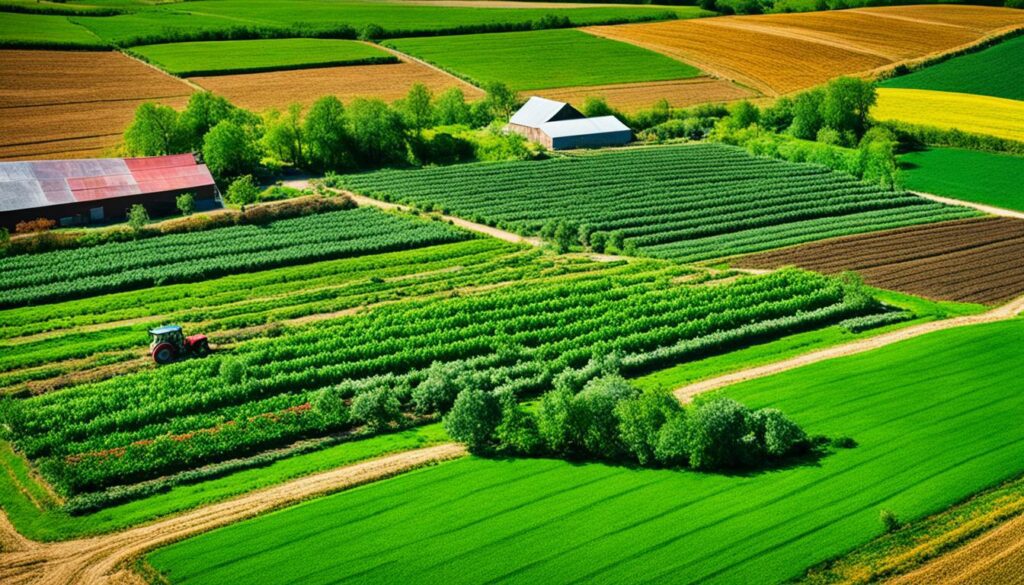
At the PFLA Biodiversity Hub, you’ll find detailed case studies from farms like Hills of Edingley and Romshed Farm. These studies show off things like where the farms are, how big they are, and what the climate is like there. They also talk about the farming activities that help biodiversity.
These practices include things like selling products directly to people and growing various herbs. The hub also talks about how important rotating animals on pastures is. It underlines the key roles of pasture, animals, and soil. It says the soil is a major carbon store and a big help for biodiversity.
The PFLA’s biodiversity hub helps farmers learn from others’ success stories. This helps them make their farms more bio-diverse. And this, in turn, helps make agriculture more sustainable.
The hub plans to grow, adding more and more useful resources. This commitment helps individual farms get stronger. It also helps the whole farming community play a bigger role in protecting biodiversity.
All around the world, many examples show the success of sustainable farming. They use plant genes well and include local knowledge and women. These efforts are guiding the future of farming.
Sustainable projects help make sure there’s enough food for everyone. In Canada, a study on insects that help plants shows the need for a varied ecosystem. This ensures crops grow well and can cope with changes. Brazil also teaches us a lot about the key role of insect pollinators in our food supply.
In India, the use of Azobacter bacteria boosts food growth. This method is part of a wider programme promoting biodiversity and agriculture. China’s Eco-Farming model also stands out by blending nature protection with farming practices.
| Country | Initiative |
|---|---|
| Tanzania | Sisal Biogas Initiative |
| India | Azobacter for Agrobiodiversity |
| China | Eco-Farming Model |
| Brazil | Sustainable Use of Pollinators |
Preserving plant genes is key for farming to last. The FAO’s work in coffee areas keeps vital plant types safe. UNESCO helps southern Africa keep local fruit trees for future food needs. These actions are vital for our long-term food safety.
In India, involving women and local people has been a win. Women lead in looking after seeds and making crops more varied. This helps farm variety grow and makes communities stronger.
Lessons from Swaziland show how local wisdom can fight off food shortages. This was seen in dealing with HIV/AIDS and dry times. These examples underline the value of local traditions and including women in farming. They show us how to better farm for the future.
The story of natural farming in Lao PDR highlights how old practices help keep the environment rich. These methods also support the lives of many in the countryside. With most of the population living off the land, this focus is critical.
These traditions are part of Lao PDR’s culture. They involve things like rotating crops and planting different things together. The lush forests here cover more than half the country, showing the close tie between people and nature.
In Lao PDR, the ways of farming are linked to the culture. These long-standing techniques show how people and the land can thrive together. By farming in cycles and mixing plants, farmers create healthy ecosystems.
The effects of these practices are huge, both for the economy and nature. The SUFORD-SU project, reaching over 3.6 million hectares, is a great example. It helped people earn more while protecting the forests.
Efforts like the Biodiversity Conservation Corridor help too. They protect animals like tigers. Imagine the positive change for both people and wildlife!
Look at Baan Thahou, for example. Families there got support that boosted their income and cut down illegal activities. This proves that helping people can also protect the planet.
The captivating tale of natural farming case studies in Lao PDR reveals traditional practices that have significantly contributed to the region’s agricultural biodiversity. Not only do these methods sustain their rich natural capital, but they also underpin the livelihoods of the rural population. Given that 67% of Lao PDR’s population is rural and relies heavily on natural resources, the emphasis on natural farming and agrobiodiversity is paramount.
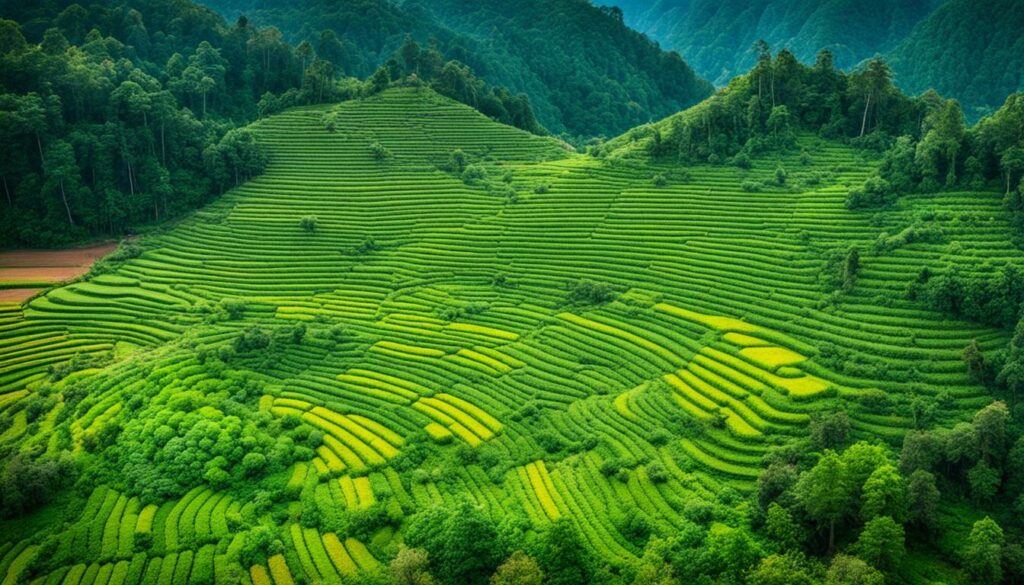
In Lao PDR, traditional farming practices are intertwined with the nation’s cultural heritage. These age-old methods showcase how indigenous knowledge and sustainable techniques foster agrobiodiversity. Farmers engage in rotational farming, intercropping, and preserving native plant species. The significance of these practices is further enriched by the diverse ecosystems where forests cover a remarkable 13.7 million hectares, translating to 58% of the country’s surface.
The economic and environmental impacts of these traditional practices are profound. The SUFORD-SU project, which managed to cover 3,626,699 hectares by 2017, exemplifies this. By improving livelihoods, the project aimed to link economic stability with forest conservation. Additionally, initiatives such as the Biodiversity Conservation Corridor Initiative have been pivotal in protecting nearly 150 threatened wildlife species, including possibly tigers and elephants.
Consider the settlement of Baan Thahou, where the project has provided grants and loans averaging $890 per family. The average family income has increased to about $240 per month, compared to the meagre earnings before the initiative. Activities such as logging and poaching have significantly decreased, demonstrating the dual benefit of economic upliftment and environmental preservation in these natural farming case studies.
China is putting more focus on farming that protects the environment. It’s doing this with new plans and team efforts to keep nature rich and healthy. The country’s big and small governments are working hard to find ways to farm without hurting the earth.
The government knows that it has to act quickly to stop the loss of plant and animal life. It has started many actions to make sure our land and wildlife can grow again. These actions help to undo the harm from how farming was done before.
The steps taken are not just quick fixes. They are part of a big plan to take care of our whole natural world. China is really serious about this. It’s making safe areas for plants and animals, teaching farmers how to grow food without harmful chemicals, and using less dangerous stuff on their crops.
Farmers, scientists, and the government are working together to save our world’s plants and animals. This team effort has spread a way of farming that helps nature and lasts a long time. It’s a way of farming that is good for both people and the planet.
This way of working together has already shown good results. Groups of farmers share natural ways to keep pests away and use water wisely. They also keep an eye on the health of their surroundings. By teaming up, they are making farms that grow good food and do not harm nature.
| Aspect | Impact |
|---|---|
| Agricultural Land Occupation | 56% of China’s land area |
| Biodiversity Loss Due to Land Use | 30% |
| Economic Loss from Air Pollution | 32 billion yuan |
Using ways to help nature and following China’s new farming ways are key to fighting the bad effects of too much farming. By working together, China can make sure its farms are safe and friendly to the earth down the road.
In Tanzania, agroecology is bringing many success stories. It connects sustainable farming with helping local communities. This work boosts food security, reduces poverty, and fights climate change.
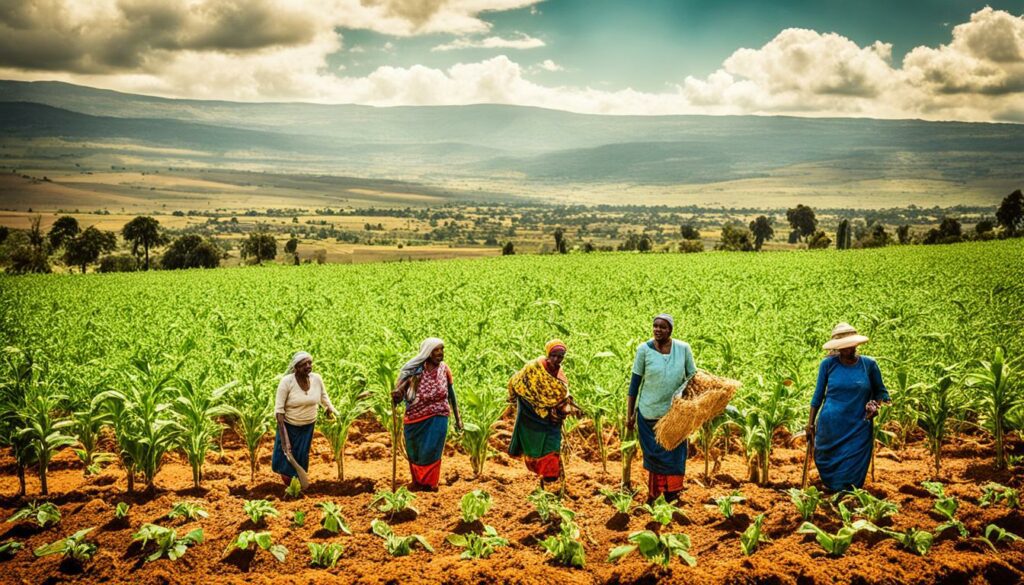
The AEE programme, headed by Ruth Nabaggala, has changed the lives of 100,000 farmers. They’ve moved from just getting by to starting their own businesses. This change means better incomes and lives for many families in Tanzania. Charles Tumuhe’s efforts have also lifted the income of 50,000 farmers by 20%.
Keeping ecological balance is key in the agroecology success. Ndeye Awa Gueye’s work to support farmers managing seeds and grow diverse crops protects nature. It helps ecosystems stay strong for sustainable farming. Also, SAT training has helped 171 farmers learn about organic farming and soil health. Now, 70.76% of them are using these methods.
| Individual | Role | Impact |
|---|---|---|
| Ruth Nabaggala | AEE Project Officer | Supported the transition of 100,000 farmers to entrepreneurship |
| Charles Tumuhe | Healthy Soil Healthy Food Project Officer | 20% increase in income for 50,000 farmers |
| Ndeye Awa Gueye | Project Officer | Policy advocacy for FMSS and promotion of neglected crops |
AFSA has shown that agroecology boosts farm yields without hurting the environment. This is a model for sustainable farming in Tanzania and beyond.
We need solid policies for a sustainable farming future. These must involve many people and encourage new ideas. A big part of our land is used for growing crops or feeding animals. This shows how important farming areas are for our food and the environment.
For good agricultural policies, many different groups should be involved. This includes farmers, scientists, and local communities. More than a billion people rely on farming in key natural areas. It’s key that their wisdom shapes our plans. We should use traditional knowledge and local efforts more. This helps everyone take part in deciding what’s best for their area and the world.
New tech and strong systems are key for farming that lasts. Only using more land doesn’t always help nature. But, mixing up what we grow and how can. This boosts our crops and fights off pests naturally. Adding different types of animals to farms can also help. It makes farms more profitable without needing as many chemicals. Governments should support these smart farming ways. They can do this by sharing new tech and making it easier to try new farming methods.
Biodiversity farming is all about making farmland better for a range of plants and animals. By mixing different species, such as in pastures for animals to eat, we boost the variety of life. This helps landscapes to be rich in nature both above and below the ground.
Biodiversity farming is key to keeping farming sustainable. It improves the safety of our food and helps us cope with a changing climate. It’s vital for keeping our ecosystems healthy. Experts say it’s a must for feeding us well in hard times.
Over time, places like Lao PDR have shown us how to use agricultural biodiversity well. It’s known as a ‘Centre of Origin’ for many plants we grow now. The way they farm helps keep their plants diverse and supports their economy.
Hills of Edingley Farm in Nottinghamshire uses special techniques to increase biodiversity. They keep a close eye on the life in their fields. This focus has made them a leading example in farming that’s good for wildlife.
At The Ethical Dairy, David and Wilma focus on keeping the soil healthy and managing pastures in new ways. They use methods like moving animals around the land and limit harmful chemicals. These actions not only help wildlife but also show how to farm in a better way.
Cat Frampton mixes art with sustainable farming in Dartmoor. Her farming ways are not only creative but also good for the land and animals. They help different species thrive, making the area more colourful and lively.
Fidelity Weston had tough times with the land at Romshed Farm. She tackled the issues by using herbal plants and moving animals around. These choices vastly improved the farm’s life variety, making it a success in green farming.
Andy Rumming’s actions at Waterhay Farm are all about farming in ways that don’t harm the environment. He uses methods that are great for local plants and animals. This shows how farming can support a rich and varied environment.
Bella Lowes designed Mill Barton Farm to do well for nature. The layout means there are lots of different habitats animals and plants can enjoy. It’s a great model for how farms can be full of life.
Ian Boyd uses smart ways to feed his animals and care for the land at Cotswold Beef. His methods are great for nature. They make his farm a shining example of how to farm in a way that’s good for the earth.
Denise Walton’s Peelham Farm uses smart practices that are natural and responsible. By breeding animals without chemicals and selling directly, they prove how good farming can be. They give us lessons on how to farm healthy and safe food.
The PFLA Biodiversity Hub shares useful info like success stories and guides for farmers. Its aim is to help farmers boost the variety of life on their land. This hub is great for farmers wanting to grow in a way that’s long-lasting.
Sustainable agriculture is vital for food safety all over the world. Its smart use of plants and the knowledge of locals helps a lot. In places like India, women play a big role in making sure we have plenty to eat, showing us how important everyone is in caring for our food.
In Lao PDR, farming in the old way has big benefits for the land and its plants. These traditional methods are key for keeping many types of plants around. They are important because they help protect and keep diverse plants healthy.
The Chinese government has smart plans to look after diverse life and encourage farming that’s not harmful. Their ways, which include working together on farms, are seen as very effective. China is working hard to farm in ways that are good for all life.
In Tanzania, doing agroecology right is proving to be very good for nature and for the people who farm. Successes there tell us the money nature makes is valuable. It shows the benefits of farming in ways that look after the earth.
To make farming even better, policies should get everyone involved and help with new tech and ways of working. These steps are really important in moving farming towards a brighter future for all.